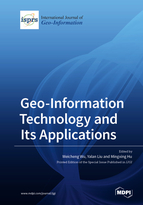Geo-Information Technology and Its Applications
A special issue of ISPRS International Journal of Geo-Information (ISSN 2220-9964).
Deadline for manuscript submissions: closed (30 June 2021) | Viewed by 58633
Special Issue Editors
Interests: environmental remote sensing; land resource mapping; land degradation; multi-biome biomass; natural hazard risk zoning and machine learning
Special Issues, Collections and Topics in MDPI journals
Interests: intelligent remote sensing information extraction for natural resource and environment, including land cover/land use change, disaster monitoring and assessment, and key technologies of space information integration
Special Issues, Collections and Topics in MDPI journals
Special Issue Information
Dear Colleagues,
Geo-information technology has been playing a more and more important role in environmental monitoring, land resource quantification and mapping, natural hazard damage and risk assessment, urban planning, smart city development and other land use change monitoring and modeling. New advancements and innovations have been achieved especially with the emergence of big data mining and machine learning including deep learning technique. It is hence the objective of this special issue to provide a platform for worldwide experts in these fields to exchange, communicate and share their outcomes and experiences to promote the advancement of geo-information technology and its applications. This special issue will cover the following topics:
- Machine learning and big data mining technique
- Land resource assessment and management
- Natural hazard damage assessment and risk zoning
- Urban planning and smart city development
- 3D modeling and applications
- Geo-information in geological exploration and mining
Guest Editors
Prof Dr Weicheng Wu
Prof Dr Yalan Liu
Prof Dr Mingxing Hu
Keywords
- Geo-information technology
- Machine learning
- Big data mining
- Land resource mapping and management
- Hazard damage and risk assessment
- 3D visualization
- Smart GIS and smart city
- Geological exploration and mining








